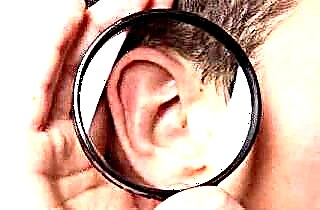In most cases, the formation of a lump in the ear indicates that this manifests itself as inflammation of the skin appendages (furunculosis, folliculitis). Moreover, as the lump in the auricle grows, it hurts more, which is especially noticeable when chewing or when trying to press on the tragus to cover the auditory opening.
Causes of painful swelling
 A tumor in the ear also raises suspicions for various infectious and inflammatory processes - otitis media. Some forms of otitis media can also be described as a ripening of a lump in the ears. For example, with bullous otitis media in the tympanic cavity there are bubbles filled with bloody contents - bullae. After the bullae burst, blood is released from the ear canal. However, this form of otitis media is not accompanied by severe pain.
A tumor in the ear also raises suspicions for various infectious and inflammatory processes - otitis media. Some forms of otitis media can also be described as a ripening of a lump in the ears. For example, with bullous otitis media in the tympanic cavity there are bubbles filled with bloody contents - bullae. After the bullae burst, blood is released from the ear canal. However, this form of otitis media is not accompanied by severe pain.
If it is not possible to consult a doctor for professional diagnosis, and it is necessary to take measures to prevent the development of the disease, you can focus on some of the symptoms characteristic of various diseases.
- Acute infectious otitis media. It is accompanied by a sudden sharp pain, which is described by the sick word "shooting". Body temperature rises above 37.5C. A yellow-white or transparent secret stands out from the ear canal. However, with different forms of otitis media, variations in symptoms occur:
- mild itching pain sometimes indicates that the cause of the disease is a fungal infection,
 an unpleasant smell of a secret - that the bacteria of staphylococcus and streptococcus became the cause of infection,
an unpleasant smell of a secret - that the bacteria of staphylococcus and streptococcus became the cause of infection,- long-term development of processes and a gradual increase in symptoms with a feeling of overflowing water in the ear is characteristic of allergic otitis media.
- Furunculosis and folliculitis. The site of inflammation is the canal and the shell. Usually, a boil is detected by pressing on the lower wall of the shell or tragus - such a lump in the ear hurts when pressed. However, a more reliable diagnosis is made if it is possible to see the characteristic canonical elevation of the boil. To consider it, the lobe is usually pulled back, which, in case of furunculosis, is also accompanied by pain.
- Wen. At the time of formation, the wen looks like a pimple with redness and tension on the shiny skin above it. With its inflammation, a local increase in temperature is recorded, and with the development of the disease, symptoms of general intoxication are noted.
- Ear plug. In this case, hearing impairment, congestion in one ear, and pulling pain are observed.
- Foreign bodies that create a feeling of an inflamed formation in the patient can be detected by visual examination with the help of a mirror.
- Lymphadenitis. With an increase in regional parotid lymph nodes, pressure may occur. This condition is accompanied by a deterioration in health, headache and weakness.

- The manifestation of caries and other dental problems is also often given off by unpleasant sensations and itching in the ear canal.
- Laryngitis and sore throat are often accompanied by ear pain, along with which, as a rule, cough and burning sensation in the throat are noted.
- Perichondritis and mastoiditis. In these diseases, either the auricle is affected in areas where cartilaginous tissue is present (perichondritis) or the mastoid process behind the concha, related to the temporal bone (mastoiditis). With the development of mastoiditis, severe ear pain can also be recorded, however, in this case, its localization is shifted to the deep sections (in comparison with furunculosis), and the course of the disease is accompanied by hearing impairment. In case of intra-aural inflammation, these two diseases during self-diagnosis, as a rule, are easily excluded immediately upon detection of specific external signs.
 Various reactions in the ear can also manifest neuritis and neuralgia. If the patient himself or the ENT doctor does not find any pathology, and the pain arises, as if "out of nowhere", then the following reasons of a neuralgic nature are possible:
Various reactions in the ear can also manifest neuritis and neuralgia. If the patient himself or the ENT doctor does not find any pathology, and the pain arises, as if "out of nowhere", then the following reasons of a neuralgic nature are possible:
- pain in the anterior part of the surface of the auditory canal indicates dysfunction of the temporomandibular joint,
- compression of the greater occipital nerve gives off soreness into the sink,
- pain in the ear membrane is provoked by diseases of the internal organs (more often the stomach) - in this case, the eardrum is innervated by the vagus nerve.
The following are the most common causes of a painful lump or tumor.
Furunculosis
The occurrence of a boil is considered the most common reason for visiting a doctor with a painful lump in the ear. In the external auditory canal, the process first manifests itself in the form of itching, after which a sensation of tissue tension and soreness arises. Pressing the tragus, pulling the lobe, yawning, and chewing increase the pain response. On visual inspection, you can see the edematous skin of the ear canal and sometimes - the cone of the boil with a purulent head.
When diagnosing, you should pay attention to the lymph nodes that are located near the focus of inflammation - they are likely to be enlarged, and they will react painfully to palpation.
Fat (lipoma)
It often takes a long time for the wen to be found. Lipoma is painless, at first it has a soft texture and grows slowly. However, in case of damage to the wen, pain can also occur.
The growth of a tumor can also lead to the same consequences if the formation is localized near the nerves. Then, with its increase, the lipoma begins to press on the nerve processes. This condition can also be perceived by the patient as if something is swollen in the ear and hurts.
Sulfur plug
Usually, a person does not experience any unpleasant sensations until the moment when the sulfur plug increases in size so that it blocks the ear canal. The increase occurs gradually, but the manifestation is usually sudden. This happens mainly after water enters the auditory canal, which leads to a sharp increase in the volume of the plug and blockage of the auditory canal. As a result, there is congestion, noise, hearing impairment, and often autophony (the sound of one's own voice).
Since the sulfur plug hardens as it grows, it can be subjectively perceived by the patient as a dense formation or "bump". If at the same time the cork begins to produce pressure on the eardrum, then headache and dizziness, nausea reflexively occur. And after this, inflammation (myringitis) and otitis media can develop, which causes pain directly inside the ear.

Home therapy and first aid
Self-medication unnecessary risk can do more harm than illness. This, for example, concerns the pouring of therapeutic fluids into the ear canal in the event of a perforation of the tympanic membrane. Accordingly, determining the integrity of the membrane is the first and mandatory step.
 In the hospital, the condition of the membrane can be determined using otoscopy and sampling. But what to do if the ear inside is swollen and sore, and only folk remedies and the contents of a first-aid kit are at hand to alleviate the condition? To check the integrity of the membrane, some patients, at their own peril and risk, clamp their mouths and try to exhale with extreme caution. If the membranes are tense ("swell"), then they are considered intact. If air comes out, damaged. However, this method itself can lead to an aggravation of the condition.
In the hospital, the condition of the membrane can be determined using otoscopy and sampling. But what to do if the ear inside is swollen and sore, and only folk remedies and the contents of a first-aid kit are at hand to alleviate the condition? To check the integrity of the membrane, some patients, at their own peril and risk, clamp their mouths and try to exhale with extreme caution. If the membranes are tense ("swell"), then they are considered intact. If air comes out, damaged. However, this method itself can lead to an aggravation of the condition.
If, nevertheless, the integrity of the membrane and the diagnosis is beyond doubt, with inflammation and purulent sections in the deep parts of the ear, the following are used as folk remedies:
- Garlic, from which a gruel is made, mixed with oil and infused for 10 days. This extract, in turn, is mixed with glycerin before instillation.
- Aloe. The juice obtained during squeezing is heated and, when instilled, relieves inflammation, since it is a natural antiseptic.
- Juniper. To put a tampon in the ear canal, a plant extract is used, which can be obtained from various organs of the juniper, however, the maximum concentration of pinene, terpinene, camphor is contained in cone berries.
Among the pharmaceutical preparations for the same purposes are used:
- Furacilin (solution) 5 drops daily (it is preheated to room temperature). However, the drug may aggravate allergy symptoms and is not recommended if ulcers and erythema are found.
- Otipax drops. While maintaining the integrity of the tympanic membrane, it can be used in the treatment of children.

For infectious lesions of the external auditory canal, the following remedies can be used:
- Iodine (5%). This solution is used to lubricate the areas of the shell affected by inflammation.
- Ichthyol ointment - applied externally.
- Menthol (solution) in 1% peach oil - softens, soothes and relieves pain.
- Hypertonic solution with 0.8% salt content - a tampon moistened with it is carefully inserted into the canal and closed with a bandage. Replacement is done 1-2 times a day.
Allergic otitis media before a visit to the doctor is fought with the help of tavegil, calcium gluconate (1 tablet 3 times / day before meals), as well as the elimination of allergens from food and the inclusion of vitamins. The recommendations of traditional medicine suggest the addition of chamomile, yarrow, and duckweed to the diet.
The sulfur plug can be dissolved and washed out with a 3% solution of hydrogen peroxide, as well as with drops of Remo-Wax and Cerumen. If there are no drops, the cork is washed out with water heated to body temperature. The liquid is injected very smoothly so as not to create unnecessary pressure, and the patient is laid so that the water comes out on its own, by free flowing out. The presence of sulfur fragments in the leaked water indicates the success of the procedure.

 an unpleasant smell of a secret - that the bacteria of staphylococcus and streptococcus became the cause of infection,
an unpleasant smell of a secret - that the bacteria of staphylococcus and streptococcus became the cause of infection,

